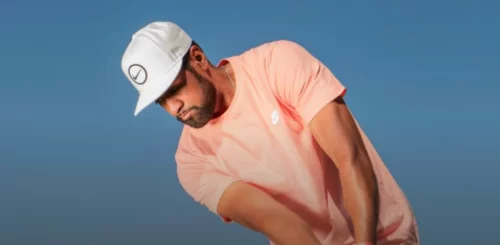In addition to copying that when you want to air one out, make sure you do two other things. The first is to set up so that you can catch the ball on the upswing and launch it higher. Tee it high and stand a little wider, which makes your spine tilt away from the target a little more like you see Tony doing here (above). The second thing? Find the center of the face. Your fastest swing won’t produce your longest drive if you don’t hit it out of the center of the face.
STAND NARROW AND SWING LEVEL
Tony loves to hit a baby cut that flies a little lower and shorter than a normal drive but is way more reliable than the bomb. Some people say to play it farther back in your stance to hit this shot, but it’s hard to start the ball left when you play it back. Instead, Tony narrows his stance, which sets his spine more vertical (above). Along with teeing it down a little, the narrow stance keeps the shot down without changing his ball position.
Now here’s the real key: Swing with your normal speed—no holding back—and feel like the club is moving level with the ground through the hitting area (above). Teeing it down a little and narrowing your stance like Tony does will help you launch it lower, so you’ll find more fairways. Don’t try to hit down on the ball, or you’ll put too much distance-robbing spin on it.
Compression is the key to great iron play and Tony does some things at address and during the swing to make sure he strikes the ball while his irons are still moving on a downward angle of attack. Even though he’s not taking a big divot here, his club is still moving down a few inches past impact. That’s why Tony and other great ball-strikers can hit a 6-iron well over 200 yards. They are essentially delofting the club as it strikes the ball, turning a 6-iron into a 3-iron.
Two other things to note about his iron play: 1) Tony has the shaft of his irons leaning toward the target a little at address. This is a great way to “preset” the position you want the club’s shaft to be in at impact. 2) Tony loads into his trail side as he takes the club back, which is key to generating power into the ball, but notice that he doesn’t sway away from the target. If you move off the ball, you’ll have to sway in the opposite direction in the downswing or you’ll hit it fat or thin. It’s tough to compress it with all that lateral movement.
Let’s start with the one thing Tony doesn’t do to hit this lower-trajectory wedge shot. He doesn’t set up with the ball back in his stance, which is a common tip for this play. That ball-back position creates a steeper angle of attack and makes the ball spin more, which in turn, makes it fly higher. Instead, play it in the same position you’d hit a normal wedge shot, but bring your trail foot in toward your lead foot, narrowing your stance.
Then when you swing, you want to feel like your head and sternum stay over the top of the ball through impact. If your head and sternum are behind the ball, you’ll likely add loft to the shot or make poor contact.
To take spin off, which is key to keeping it down and controlling distance, Tony clubs up and makes a swing at an unhurried pace. Try your 9-iron from where you’d normally hit a pitching wedge, and when you swing, think—stay smooth.
SQUARE UP AND STAY STACKED
When Tony chips, he loves to hit a low spinner. I like this shot for amateurs because it eliminates some common chipping mistakes, like leaning back with the upper body or trying to help the ball in the air.
Tony sets up with his shoulders and hips square to the target, but the clubface is noticeably open. He does that to counter his bowed left wrist, which would deloft the club too much coming into impact. His other key at setup is to make sure his head and sternum are over the ball.
When he swings, his grip pressure stays light to add some feel in his hands, but his upper-body rotation is mostly responsible for the shot. He swings down his target line (above) and hits a little down on the ball with a slightly forward-leaning shaft. That produces the low, spinny chip.
SET THE SHAFT AND BE WRISTY
Tony is never shy about using a putter from off the green. Nor should you be.
If you choose the putter, there are a couple of technique changes Tony makes. First, he sets the shaft so that it’s vertical or leaning a touch away from the hole. Why? You want to make sure you have enough loft on the face to get the ball through the fringe easier. Second, you need more power in your stroke, but you don’t want a lot of body movement to get it or you risk a mis-hit. Instead, Tony gets some extra power by hinging his wrists a little going back (below) and putting some pop into the ball.
When you knock it close from off the green with a putter, I guarantee someone is going to say, “Nice shot.”







